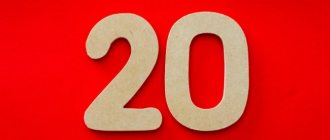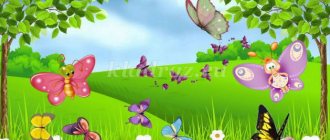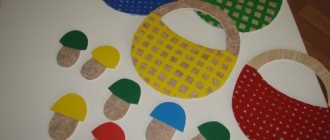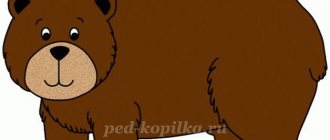Summary of the book
The content of this methodology meets all the requirements of the Federal State Educational Standard and includes the following sections:
- studying the properties of objects and numbers;
- patterns;
- numbers;
- quantities;
- spatiotemporal representations.
Children in kindergarten
At a younger age, they study only numbers, and at an older age they study simple arithmetic operations with them. All classes should be conducted taking into account the child’s leading activity in the preschool period - play. But lessons should be conducted regularly so that the knowledge gained is systematized.
For children 4-5 years old
This part of the manual is not aimed at memorizing and memorizing, but at developing in children the ability to independently draw conclusions, reason and prove their point of view. There is no need to force him to study mathematics; teachers should try to motivate him.
Important! The book should not be given in full at once: you need to cut off the pages as you complete tasks and put them in a separate folder. And at the end of the school year it can be given to the student’s parents.
This tutorial covers the following topics:
- "Repetition";
- "Earlier, later";
- “Height comparison”;
- "Number and figure 4";
- "Square";
- "Cube";
- "Up, Down";
- “Width comparison”;
- "Number and figure 5";
- "Oval";
- "Inside Outside";
- “In front, behind, between”;
- "Pair";
- "Rectangle";
- "Number series";
- “Ri;
- "Ordinal counting";
- "Comparison by length";
- "Number and figure 7";
- “Numbers and figures 1-7”;
- "Comparison by thickness";
- "Higher lower";
- "Plan";
- "Number and figure 8";
- "Cylinder";
- "Cone";
- "Prism and Pyramid".
Important! After studying all the topics, the second part of “The Game” contains tasks for repeating all the material.
Each section offers several exercises for practicing and consolidating:
- comparison;
- complete the figures;
- connect the dots;
- find an extra item and explain why;
- paint over the required number or suitable figure;
- passing the labyrinth;
- drawing up proposals.
Exercises have a positive effect on the development of fine motor skills and speech development. All topics are illustrated, because when working with preschoolers you need to use visual material. It is important that the teacher does not give children ready-made answers, but helps them find the answer to the questions on their own. At the age of 4-5 years, teachers develop an interest in studying mathematics.
Boy doing math
For the average group 5-6 years old
In Peterson's book, Mathematics for Preschoolers, middle grades begin introducing children to simple arithmetic and expanding upon their existing knowledge. In this manual for the middle group, the following sections are studied in detail:
- properties of objects;
- comparison;
- addition;
- work on spatial representations of ON, OVER, UNDER;
- work on the concepts of “right”, “left”;
- subtraction;
- work on the concepts of “between”, “in the middle”, “inside”, “outside”;
- one-many;
- study of figures and numbers.
How to teach children to solve problems in mathematics in a preschool educational institution
In the middle group, more time is allocated to the study of each topic, because these are the first steps for children to go to school.
Important! Classes should not be too long. It is necessary to arrange physical minutes and a change of activity.
Preschoolers are offered to perform the following types of exercises:
- search for identical features and differences;
- search for similar shapes and paint over them;
- searching for extra items;
- working with tables.
The child must give a detailed answer to almost every exercise. Thus, the development of coherent speech and grammatical structure occurs. Several lessons are allocated for the study of each topic, because the material becomes more complex. Therefore, the use of Peterson's mathematics manual for children 5-6 years old allows for an integrated approach to learning.
For preschoolers 6-7 years old
In the preparatory group, most of the classes are devoted to practicing arithmetic operations. New topics include the following:
- area measurement;
- length measurement;
- mass measurement;
- watch.
Didactic games
Peterson’s book “Preparing for School for 6-7 Years” offers handouts so that preschoolers can apply knowledge in practice and better master the knowledge they have acquired.
The advantage of this technique is that it is not a mathematics textbook for kindergarten, but a workbook. And you can study with notebooks “One is a step, two is a step...” at home. The tasks are appropriate for the child’s age and become more difficult gradually. It is advisable to conduct lessons in a playful way so that children do not lose interest in learning a new subject for them.
Series of notebooks “Igralochka” L. G. Peterson (material)
Series of notebooks “Player” - L. G. Peterson, E. E. Kochemasova
I really liked the descriptions of these notebooks and decided to find them to download. Maybe it will be useful to someone. Write, I will send it to everyone by email after Easter.
Here is a list of what I have.
The format is different: PDF and DJVU.
For those who don’t have it, you can download and install special programs here: for PDF, for DJVU
1. Peterson L.G. Kochemasova E.E. Playing game. Practical mathematics course for preschoolers. Guidelines.
Publisher: Ballas Year of publication: 2002 Pages: 174 Format: djvu Size: 6.58 MB
Methodological recommendations for the development of mathematical concepts in children 3-4 and 4-5 years old. It is the initial element of the continuous mathematics course “School 2000...” Contains a brief description of the concept, program and organization of practical classes with children.
2. Peterson L.G. Kochemasova E.E. Playing game. Part 1.
Publisher: Balass Artist: Petr Severtsov Year of publication: 2004 Pages: 84 Format: djvu Size: 4.3 Mb
3. Peterson L.G. Kochemasova E.E. Playing game. Part 2.
Publisher: Balass Artist: Petr Severtsov Year of publication: 2004 Pages: 84 Format: djvu Size: 3.99 Mb
The “Igralochka” series of notebooks includes:
4. “Playing Game” - mathematics for children 3-4 years old (part 1);
Igralochka" - mathematics for children 3-4 years old consists of 80 pages with exciting and colorful tasks. This notebook covers topics such as “color” (4 lessons of 2 tasks), “shades of colors” (3 lessons of 2 tasks), “big and small” (2 lessons of 2 tasks), “color and shape” ( 1 lesson), “one-many”, “same, more, less” (4 lessons), “counting to two. number 2”, “number and figure 1 and 2”, “longer, shorter”, geometric shapes: circle, ball, triangle, “counting to three”, “number and figure 3”, “on, above, under”, “ above, below”, “left, right”, and 6 lessons to review everything covered. There are a total of 32 lessons in the notebook, which take up an entire page. Each lesson has two tasks. There are also 2 pages of handouts. (I took the description here https://otzovik.com/review_1130981.html)
5. “Playing Game” - mathematics for children 4-5 years old (part 2);
“Igrachka” - mathematics for children 4-5 years old also consists of 80 pages. The entire notebook can be divided into 2 sections: 32 activities and guidelines for parents. In this notebook there is an increase in the number of tasks in a lesson: from 4 to 6 tasks in one lesson. But each lesson takes up a whole turn. In this part, topics such as “earlier, later”, “number and figure 4”, “square”, “cube”, “above, below”, “width comparison”, “number and figure 5”, “oval” are studied "", "inside, outside", "in front, between, behind", "pair", "rectangle", "number series", "rhythm", "number and figure 6", "ordinal counting", "length comparison" , as well as the study of numbers and figures 7 and 8, comparison in height, study of volumetric figures: prism, cylinder, cone, pyramid. And 3 lessons for repetition. (I took the description here https://otzovik.com/review_1130981.html)
6. “Playing Game” - mathematics for children 5-6 years old (part 3);
7. Playing step to school. Mathematics for children 6-7 years old. Part 4 (1)
8. Playing step to school. Mathematics for children 6-7 years old. Part 4 (2)
9.10. Handouts for “Playing Games” for 3-4 years and 4-5 years.
11.
This collection also includes a
“Problems in Crosswords” notebook for children aged 5-7 years.
Peterson preschool education: how to conduct classes
The learning process in this manual should be built taking into account the following methodological principles:
- Creating a favorable psychological environment is one of the main principles in training. A comfortable environment has a beneficial effect on the general condition of the child.
- Activity approach - a preschooler learns about the world not by receiving ready-made answers, but as a result of independent search. An adult is more of an observer.
- Individual approach - the teacher creates situations in which each child in the group feels like part of the team.
- Integrity - the learning process is not limited to kindergarten. One of the teacher’s tasks is to convey to parents the importance of continuing the educational process during other activities.
- Variability - the use of tasks with multiple answer options.
- Creative approach - here it is important not only to encourage the child’s creative activity, but also to work together with adults.
- Continuity.
Important! Group classes according to Peterson using situational technology, which helps make the educational process interesting for children.
FEMP classes in the 2nd junior group according to Pomoraeva and Pozina
There are 3 types of situations in the lesson:
- “discovery” of new knowledge;
- training;
- final.
A feature of the first type of classes is the implementation of educational goals with the study of new mathematical topics. Children are given the opportunity to reason and find the answer on their own. At the beginning of classes, the teacher introduces a new topic and talks about its significance. Next, he creates a difficult situation, which results in the “discovery” of new knowledge.
To do this, the teacher invites the student to perform an action using new knowledge. Thanks to this, the adult brings the preschooler to the realization that he is not yet ready to perform new skills. Solving practical exercises on a new topic and consolidating it. In this lesson, the main goal of the teacher in this type of lesson is to involve the child in the educational process.
Didactic material
The teacher, by asking leading questions, encourages the child to choose a way to solve a difficult situation. As a result of the successful application of new knowledge in practice, it is imperative to praise the child. At the end, the teacher pronounces the solution algorithm without going beyond the game method.
He then creates different situations to use the new skill. Or organize a small self-test. When summing up the results, the teacher talks about the conditions due to which the result was achieved.
A training type lesson can be carried out in a playful way. The purpose of such lessons is to consolidate the acquired knowledge. But it does not take place in the form of standard memorization. The child independently finds difficulties that prevent him from mastering a new topic and coping with them. When summing up the results, the teacher should pay attention to what helped him emerge victorious.
Important! Final classes are conducted with the participation of two teachers. One of them organizes the educational process, and the second records the results obtained. The purpose of such lessons is to systematize the acquired knowledge and check how much the child has learned it.
KTP to L.G. Peterson “One-step, two-step” for preparatory groups in kindergarten.
Explanatory note
The work program was compiled according to the program of L.G. Peterson Preschool training program for children aged 3-7 years “Steps” according to the educational system of the activity-based teaching method “School 2000...”: Mathematics. – M.UMC “School 2000...”, 2007- 40 p.
Starring:
M.A Kubysheva, E.E. Kochemasova, N.P. Kholina
The program is methodologically supported by the course of L.G. Peterson, E.E. Kochemasova, N.P. Kholina “One is a step, two is a step” for children 5-7 years old.
The mathematical development program for preschoolers “Steps” is the initial link of a continuous mathematics course for preschoolers of the educational program “School 2000...”
The main goal
program is the formation of learning motivation, focused on satisfying cognitive interests, the joy of creativity, the development of imaginative and variable thinking, imagination, and creative abilities.
This goal is realized in accordance with the stages of cognition and age-related characteristics of children’s development in the system of lifelong education.
Relevance
and the practical significance of the program lies in developing the ability to purposefully master volitional efforts, establish correct relationships with peers and adults, and see oneself through the eyes of others.
This program is adapted
, since it is compiled taking into account the level of training of students and is intended for students aged 6-7 years.
The total number of hours is 62, two lessons per week, lesson duration is 25 minutes.
During the course of this program, students must acquire the following knowledge and skills.
-composition of numbers of the first ten and of two smaller numbers
-how to get each number of the first ten by adding one to the previous one and subtracting one from the next one in a series
-digits 0,1,2,3,4,5,6,7,8,9, signs +,-,=
-coins
-Days of the week
Week, month, year, time determination by clock (clockwise)
-geometric figures
- name numbers in forward and reverse order
-correlate the number and number of objects; compose and solve one-step problems involving addition and subtraction; use arithmetic symbols
-measure the length of objects using a conventional measure
-compose from several triangles, quadrangles, larger figures, divide a circle, square into 2 and 4 equal parts.
- focus on a sheet of paper.
- General concepts
Properties of objects: color, shape, size, material, purpose, etc. Comparison of objects by color, shape, size, material.
Collections (groups) of objects or figures that have a common characteristic. Drawing up a population according to a given characteristic. Selecting part of the population.
Comparison of two sets (groups) of objects. Designation of relations of equality and inequality.
Establishing the equivalence of two sets (groups) of objects using pairings (equal, not equal, more by.., less by.)
Formation of general ideas about foliation as the combination of groups of objects into one whole.
Formation of general ideas about subtraction as the removal of parts of objects from the whole.
The relationship between the whole and the part.
Initial ideas about quantities.
Natural number as a result of counting and measurement.
Numerical segment.
Drawing up patterns. Search for violations of patterns.
- Numbers and operations on them.
Count forward and backward within 10.
Forming the next number by adding one. Name, sequence, designation of numbers from 1 to 10 with numbers and dots. Composition of the first ten numbers. Number 0 and its properties.
Equality and inequality of numbers. Comparison of numbers (more by.., less by..) on a visual basis.
Formation of ideas about addition and subtraction of numbers within 10 using visual support. The relationship between addition and subtraction of numbers.
The idea of a natural number as a result of changes in quantities
(quantitative characteristics of the properties of objects)
Numerical segment. Counting and counting numbers on a number line. (Adding and subtracting numbers using a number line)
Solving simple (one-step) addition and subtraction problems using visual material.
- Spatiotemporal representations
Examples of relationships: on-above-under, left-right-middle, front-back, top-bottom, above-lower, wider-narrower, longer-shorter, thicker-thinner, earlier-later, the day before yesterday-yesterday-today-tomorrow - the day after tomorrow, along, through, etc.
Establishing the sequence of events.
The sequence of parts of the day, days in the week, months in the year.
Orientation on a sheet of squared paper. Orientation in space using a plan.
Geometric figures and quantities.
Formation of the ability to identify objects of the same shape in the environment. Introduction to geometric shapes: square, rectangle, triangle, quadrangle, circle, ball, cylinder, cone, pyramid, parallelepiped (box), cube.
Composing figures from parts and dividing figures into parts. Designing figures from sticks.
Formation of ideas about a point, straight line, ray, segment, broken line, polygon, angles, equal figures. Closed and open lines.
Concept of length, mass, volume.
Formation during game types of communication of cognitive processes and abilities for basic mental operations based on objective actions. Develop attention, memory, speech.
Forms and methods of organizing classes:
- Practical
- Verbal
- Gaming
- Educational and game
In classes with children, you need to study what magnitude, geometric shapes, orientation in space and time, quantity and counting are.
During the classes, the development of intellectual and creative powers, the ability to listen and hear, work in a team and independently, and the desire to learn something new are expected.
The system for tracking and assessing learning outcomes under the program consists of developing self-assessment skills and conducting final classes, where children’s attention is focused on the main ideas of the lesson, and here children can express their attitude to what they liked and what was difficult.
The content of the children's education program corresponds to the level of preschool education and has a scientific orientation. and is built on the basis of a system of didactic principles
:
- the principle of psychological comfort. An educational environment is created that ensures the removal of stress-forming factors in the educational process.
- principle of activity. New knowledge is not introduced in ready-made form, but through independent “discovery.”
- the minimax principle. This provides the opportunity for children to learn at different levels.
- the principle of a holistic view of the world. When new knowledge is introduced, its relationship with objects and phenomena of the surrounding world is revealed.
— The principle of continuity. Provides continuous connections between all levels of education.
These principles reflect modern views on the basics of organizing developmental education. They not only provide solutions to the problems of intellectual and personal development of students, the formation of their cognitive interests and creative thinking, but also contribute to the preservation and support of their health.
Calendar and thematic planning
| No. | Lesson topic | Actual date |
| 1 | Properties of objects. Combining objects into groups based on a common property. | |
| 2 | Properties of objects. Combining objects into groups based on a common property. | |
| 3 | Properties of objects. Combining objects into groups based on a common property. | |
| 4 | Properties of objects. Combining objects into groups based on a common property. | |
| 5 | Properties of objects. Combining objects into groups based on a common property. | |
| 6 | Comparison of groups of objects. Designation of equality and inequality. | |
| 7 | Comparison of groups of objects. Designation of equality and inequality. | |
| 8 | Comparison of groups of objects. Designation of equality and inequality. | |
| 9 | Relation: part-whole. An idea of the action of addition (using visual material) | |
| 10 | Spatial relationships: on, above, under, left, right. | |
| 11 | Spatial relationships: on, above, under, left, right. | |
| 12 | Spatial relationships: on, above, under, left, right. | |
| 13 | Removing a part from the whole (subtraction). | |
| 14 | Spatial relationships: between, in the middle. | |
| 15 | The relationship between the whole and the part. Representation: one is many. | |
| 16 | Number 1 and number 1. | |
| 17 | Spatial relations: inside, outside. | |
| 18 | Number 2 and number 2. Pair. | |
| 19 | Concept of a point and a line. Segment and beam. | |
| 20 | Number 3. Number 3. | |
| 21 | Concepts of closed and open lines. About a segment and a polygon. | |
| 22 | Broken line. Polygon. | |
| 23 | Number 4. Number 4. | |
| 24 | Understanding angles and types of angles. | |
| 25 | Concept of a number line. | |
| 26 | Number 5. Number 5. | |
| 27 | Spatial relationships: in front, behind. | |
| 28 | Comparison of groups of items by quantity on a visual basis. | |
| 29 | Designation of relations: more-less. | |
| 30 | Temporary relationships: earlier, later. | |
| 31 | Repetition. | |
| 32 | Repetition. | |
| 33 | Repetition. | |
| 34 | Math games. | |
| 35 | Numbers 1-5. | |
| 36 | Numbers 1-5. | |
| 37 | Number 6. Number 6 | |
| 38 | Number 6. Number 6 | |
| 39 | Spatial relationships: longer, shorter. | |
| 40 | Length measurement. | |
| 41 | Length measurement. | |
| 42 | Length measurement. | |
| 43 | Number 7. Number 7. | |
| 44 | Number 7. Number 7. | |
| 45 | Number 7. Number 7. | |
| 46 | Relationships: harder, easier. Mass comparison. | |
| 47 | Mass measurement. | |
| 48 | Mass measurement. | |
| 49 | Number 8. Number 8. | |
| 50 | Number 8. Number 8. | |
| 51 | Number 8. Number 8. | |
| 52 | Concept of volume. Volume comparison. | |
| 53 | Volume measurement. | |
| 54 | Number 9. Number 9. | |
| 55 | Number 9. Number 9. | |
| 56 | Number 9. Number 9. | |
| 57 | Presentation of the area. Area comparison. | |
| 58 | Area measurement. | |
| 59 | Number 0. Number 0. | |
| 60 | Number 0. Number 0. | |
| 61 | Number 10. | |
| 62 | Acquaintance with spatial figures - ball, cube, parallelepiped, pyramid, cone, cylinder. Their recognition. | |
| 63 | Acquaintance with spatial figures - ball, cube, parallelepiped, pyramid, cone, cylinder. Their recognition. | |
| 64 | Symbols. |
The importance of books in preparing for school
The importance of classes according to Peterson can hardly be overestimated if they were carried out taking into account all the recommendations. Its advantage is that it is suitable for individual work with children. It is easier for the teacher to make long-term planning so that mathematics teaching is effective.
Mathematics lesson at preschool educational institution
When using this technique, preschoolers do not lose interest in learning. This is due to the fact that game methods are used in classes and fairy-tale characters are introduced. Many studies have proven the effectiveness of teaching this way. Children are taught to think independently and look for solutions.
Also, the use of Peterson's book contributes to the development of creative thinking. Although many people miss this component when studying mathematics. The selected tasks will allow teachers to explain even complex tasks to the child as clearly as possible. As a result of classes using this educational method, children learn to cope with tasks independently. And an adult can only suggest a direction in solving a problem.







